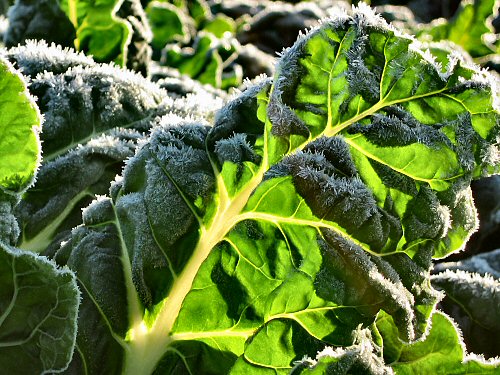
As a friendly reminder that the weather hasn’t gone entirely haywire, the nights have been cold lately, freezing or below, and some days begin with a reassuring blanket of frost on the field. Here, the Swiss chard (it’s trusty Fordhook Giant) is moments before melt-off in the morning sun. The chard can take a freezing and keep on tasting great. In fact, so can the rest of what’s out there: there’s still lots of spinach, kale, cauliflower, collards, plus beets and carrots safely in the ground. People are dropping by daily to get a last bit of whatever there is, so it all works out!




Absolutely beautiful shot of the chard. Wish I could take photos that nice. How low of a temp can chard take before it damages it? I see to cover my chard whenever there’s just the tiniest chance of frost.
Wow, nice snap shot. I am sure it’s gorgeous there this time of year! Love your blog. thanks for posting
Hey Cynthia: Chard is one of those crops you can grow through a really cold (Zone 4 US, or colder) winter in an unheated greenhouse. This is in theory, I PLAN to build a production-sized hoophouse for cold winter crops, but it’s a proven Eliot Coleman thing, growing in cold weather in unheated hoophouses. I have tried all-winter mache and lettuce in the small seedling hoophouse that I have now, and they’ve done fine. These cold-weather plants, including spinach, chard, parsley, arugula, can freeze and thaw every day, as long as they’re rooted (the ground never freezes up). Pretty amazing!
I find outdoors, what gets chard and spinach and the like in cold weather is the wind damage combined with the cold, you get brown and white cold-burned spots and leaves, and general decline. Right now, the chard in the pic is right beside 2′ oats, so it’s nice and sheltered. If the plants have some sort of windbreak, the freeze-thaw stuff alone doesn’t seem to matter, at least until the ground freezes up. Of course, in full winter, if they’re outdoors without the greenhouse effect, they’ll eventually just stay frozen, and if you cut before thawing, I think they tend to mush out (I haven’t done that…often :).
I checked out your farm site. You have a great tomato growing tips page!! How do you manage all the varieties, as far as harvest and sorting? Every year, I grow 50 varieties (most only 6-12 plants), but I end up never having the time to organize even a fraction by variety for market sales. I doubt there’s a shortcut, it’s just time, but I’d like to be able to take to market even a few contrasting varieties in one week, with individual description cards… Tips?!
Tom: Thanks! As we head into winter, get ready for lots of close-ups of TOOLS, books, IMPORTANT SHEETS OF PAPER…until seedlings start up in Feb. I’m gonna try to keep up the daily posting!
Thanks mike. Great shot. You are a “link of interest” today!
http://www.smallfarmcentral.com/blog/nov/2007/going-south-and-links-interest
Thank you! I was pretty sure my swiss chard would be fine with the first frost we are expecting…but did not know about the parsley too! I was just about to harvest all the parsley to dry it…perhaps I will leave about 1/2 of it in the garden. I forgot about hoops over the garden! Our raised bed garden was our “homeschooling project” of the year and we are trying to find ways to extend it as long as possible here in southern NH as we continue to grow herbs, kohlrabi, beets and carrots. Maybe I will try planting some lettuce seeds under a hoop frame just to see what happens. Wouldn’t it be fun to harvest lettuce for a Thanksgiving salad?!